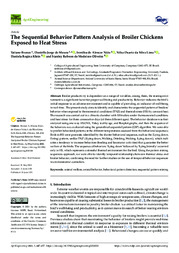The sequential behavior pattern analysis of broiler chickens exposed to heat stress.
The sequential behavior pattern analysis of broiler chickens exposed to heat stress.
Autoria: BRANCO, T.; MOURA, D. J. de; NÄÄS, I. de A.; LIMA, N. D. da S.; KLEIN, D. R.; OLIVEIRA, S. R. de M.
Resumo: Abstract. Broiler productivity is dependent on a range of variables; among them, the rearing environment is a significant factor for proper well-being and productivity. Behavior indicates the bird´s initial response to an adverse environment and is capable of providing an indicator of well-being in real-time. The present study aims to identify and characterize the sequential pattern of broilers´ behavior when exposed to thermoneutral conditions (TNZ) and thermal stress (HS) by constant heat. The research was carried out in a climatic chamber with 18 broilers under thermoneutral conditions and heat stress for three consecutive days (at three different ages). The behavior database was first analyzed using one-way ANOVA, Tukey test by age, and Boxplot graphs, and then the sequence of the behaviors was evaluated using the generalized sequential pattern (GSP) algorithm. We were able to predict behavioral patterns at the different temperatures assessed from the behavioral sequences. Birds in HS were prostrate, identified by the shorter behavioral sequence, such as the {Lying down, Eating} pattern, unlike TNZ ({Lying down, Walking, Drinking, Walking, Lying down}), which indicates a tendency to increase behaviors (feeding and locomotor activities) that guarantee the better welfare of the birds. The sequence of behaviors 'Lying down' followed by 'Lying laterally' occurred only in HS, which represents a stressful thermal environment for the bird. Using the pattern mining sequences approach, we were able to identify temporal relationships between thermal stress and broiler behavior, confirming the need for further studies on the use of temporal behavior sequences in environmental controllers
Ano de publicação: 2021
Tipo de publicação: Artigo de periódico
Unidade: Embrapa Agricultura Digital
Observações
1 - Por padrão são exibidas publicações dos últimos 20 anos. Para encontrar publicações mais antigas, configure o filtro ano de publicação, colocando o ano a partir do qual você deseja encontrar publicações. O filtro está na coluna da esquerda na busca acima.
2 - Para ler algumas publicações da Embrapa (apenas as que estão em formato ePub), é necessário ter, no celular ou computador, um desses softwares gratuitos. Sistemas Android: Google Play Livros; IOS: iBooks; Windows e Linux: software Calibre.
Acesse outras publicações
Acesse a Base de Dados da Pesquisa Agropecuária (BDPA) para consultar o acervo completo das bibliotecas da Embrapa.

